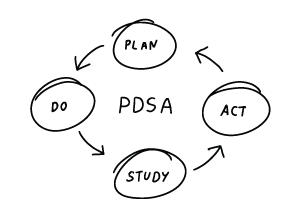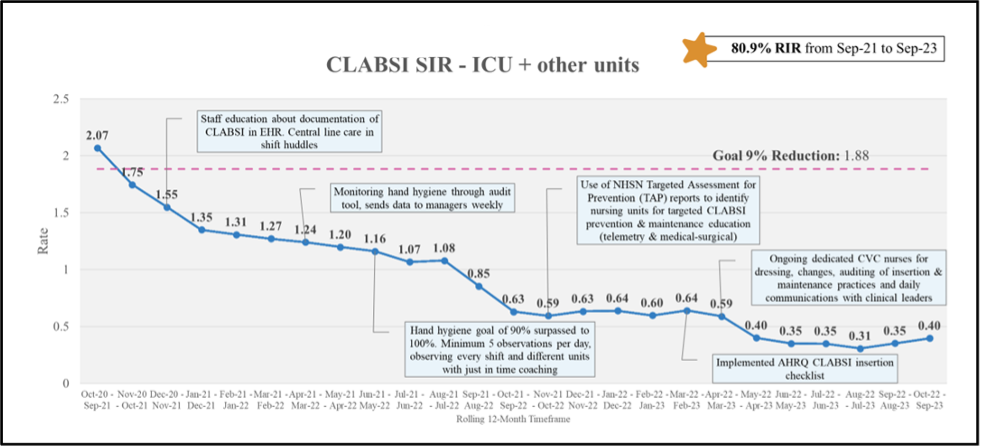The Centers for Medicare & Medicaid Services (CMS) Quality Improvement Organization (QIO) Program is dedicated to improving the quality of health care at the community level. Hospital Quality Improvement Contractors (HQICs) are strategic partners of the QIO Program dedicated to improving the quality of care delivered to people with Medicare in hospitals.
Through its role as an HQIC, Health Quality Innovators (HQI) has been working with a large Mississippi hospital to improve its Central Line-Associated Bloodstream Infection (CLABSI) rate. Working with HQI, the hospital achieved an 80.9 percent relative improvement rate (RIR) from September 2021 to September 2023. During this timeframe, 34.87 total harms were avoided, and 5.23 lives were saved for an estimated cost savings of $1,977,330. Cost savings and lives saved were calculated using methodology recommended by CMS which was based on the white paper titled Estimating the Additional Hospital Inpatient Cost and Mortality Associated with Selected Hospital Acquired Conditions1.
 HQI worked with the hospital to use the Centers for Disease Control and Prevention (CDC) National Healthcare Safety Network (NHSN) Targeted Assessment for Prevention (TAP) Reports to identify nursing units for targeted CLABSI prevention and maintenance education. The Targeted Assessment for Prevention Strategy, provides a framework for quality improvement that uses data for action to prevent HAIs by targeting hospitals with an excess burden of infections, assessing for gaps, and implementing prevention strategies. The TAP reports provide information on HAIs needed to assess infection prevention goals in a hospital. Through the hospital TAP report, infection caused by improper central line insertion and two hospital units (telemetry and medical-surgical), were identified as leading contributors to CLABSI events. HQI assisted the hospital with completing a Plan-Do-Study-Act (PDSA) cycle. Opportunities for improvement included:
HQI worked with the hospital to use the Centers for Disease Control and Prevention (CDC) National Healthcare Safety Network (NHSN) Targeted Assessment for Prevention (TAP) Reports to identify nursing units for targeted CLABSI prevention and maintenance education. The Targeted Assessment for Prevention Strategy, provides a framework for quality improvement that uses data for action to prevent HAIs by targeting hospitals with an excess burden of infections, assessing for gaps, and implementing prevention strategies. The TAP reports provide information on HAIs needed to assess infection prevention goals in a hospital. Through the hospital TAP report, infection caused by improper central line insertion and two hospital units (telemetry and medical-surgical), were identified as leading contributors to CLABSI events. HQI assisted the hospital with completing a Plan-Do-Study-Act (PDSA) cycle. Opportunities for improvement included:
- Hire dedicated central line nurses to train on proper catheter insertion technique and line maintenance
- Increase staff knowledge of CLABSIs, targeting nurses and night and weekend hospital staff whose knowledge may vary on this topic
- Improve CLABSI documentation in the hospital’s electronic health record (EHR)
- Provide additional hand hygiene protocols to support a reduction in CLABSI rates
As a result, with HQI tools and guidance, the hospital implemented the following strategies to reduce CLABSI infection rates:
Hired additional nursing staff – The hospital hired nurses with expertise in maintaining, monitoring, and utilizing central venous catheters. They provide documentation of CLABSI protocols in the hospital EHR that were previously omitted and work closely with the hospital infection preventionist and quality department to share efforts to decrease CLABSIs.
Daily shift huddles – To increase CLABSI knowledge, these daily, short meetings were led by a trained central venous catheter nurse and held for general nursing staff to learn the teaching definitions of CLABSI; maintaining, monitoring, and utilizing central venous catheters; and proper use of dressing for the catheter site. HQI provided the hospital with the AHRQ CLABSI Insertion Checklist which outlines sequential critical steps for central line insertion. The hospital uses the checklist during insertion and removal procedures.
Improved CLABSI documentation – The addition of central line nursing staff improved CLABSI documentation in the hospital EHR. These nurses are responsible for entering and maintaining CLABSI data and information, in addition to educating staff nurses on CLABSI documentation in the EHR.
Education and monitoring of hand hygiene – The team incorporated an educational hand hygiene learning module that all hospital staff were required to complete every month. For every CLABSI event, the hospital manager completed an event tool and root cause analysis (RCA). All hospital managers were required to present their results regarding infections and RCAs at monthly CLABSI/CAUTI reduction committee meetings. Hand hygiene is monitored through an EHR audit tool and data is sent to hospital managers weekly.
The hospital’s hand hygiene goal of 90 percent escalated to 100 percent. A minimum of five observations per day were completed – observing every shift and different units with “just in time” coaching that spontaneously occurs when hospital managers observe an opportunity for a hospital staff member to be coached.
Additionally, at HQI’s recommendation, the hospital incorporated a nasal sanitizer antiseptic to reduce the risk of CLABSI for patients by killing bacteria in the nasal vestibule. This product also aids in the prevention of other types of HAIs, such as catheter-associated urinary tract and surgical site infections2.
Figure 1 below illustrates the hospital’s progress between September 2021 to September 2023 to reduce their CLABSI rate.
Figure 1. CLABSI SIR – ICU + Other Units

Creating Hospital Mentorship
HQI has utilized the opportunity as an HQIC to create mentoring relationships between hospitals. Partnering mentor hospitals with like-size underperforming hospitals, has allowed mentor hospitals to share experiences and best practices to help underperforming hospitals decrease infections.
The featured hospital in this article served as a mentor hospital. They partnered with another hospital to help improve CAUTI rates. One intervention shared was the use of a nasal sanitizer antiseptic that the mentee3 hospital adopted.
Keys to Success
HQI’s success can be replicated by taking the following steps:
- Assist hospitals through data to help identify HAIs that need improvement.
- Coach hospitals and provide existing tools and resources to assist them in reducing HAIs.
- Facilitate hospital mentorship to share best practices between hospitals to reduce HAIs.
For more information, visit hqin.org.
1 Bysshe, T., et al. "Estimating the additional hospital inpatient cost and mortality associated with selected hospital‐acquired conditions." (2018).
2,3 Increased Risk of HAIs and the Case for Patient Decolonization in the COVD-19 Era. https://www.nozin.com/increased-risk-of-hai-and-the-case-for-patient-decolonization-white-paper/
__________________
This material was prepared by The Bizzell Group (Bizzell), the Data Validation and Administrative (DVA) contractor, under contract with the Centers for Medicare & Medicaid Services (CMS), an agency of the U.S. Department of Health and Human Services (HHS). Views expressed in this material do not necessarily reflect the official views or policy of CMS or HHS, and any reference to a specific product or entity herein does not constitute endorsement of that product or entity by CMS or HHS. 12SOW/Bizzell/DVA-1223-10/24/23

